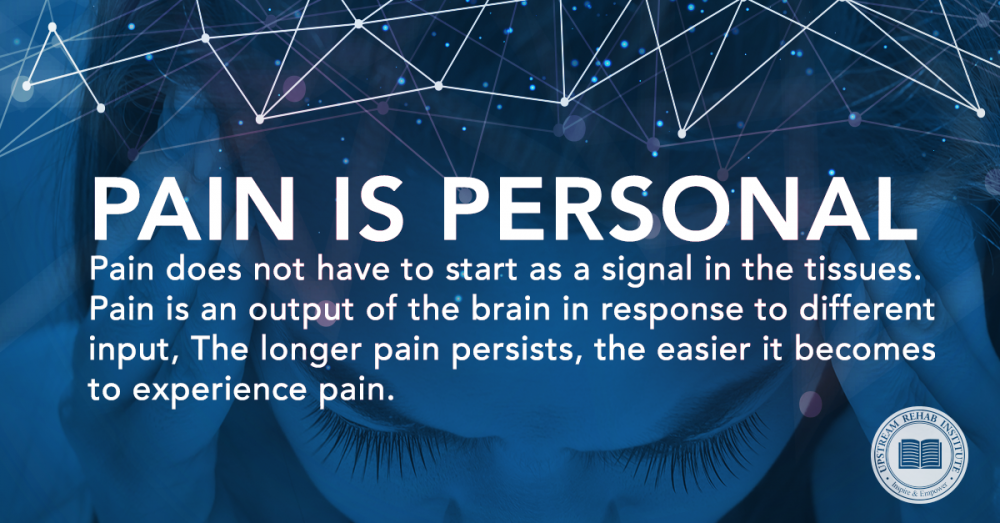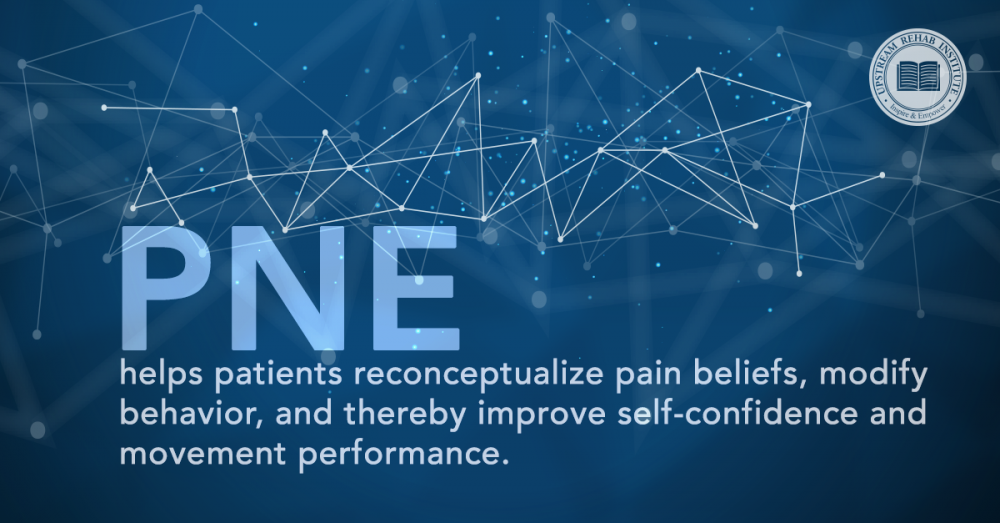Anjanette C. Nuñez, PT, DPT, OCS

Chronic pain is complicated and challenging to treat. Approximately 1.5 billion people worldwide1 and 25 million adults in the US2 suffer daily from chronic pain. Opioid prescription for those with chronic pain has consistently risen and is associated with higher rates of abuse, addiction, and overdose. In 2017, approximately 58 opioid prescriptions were written for every 100 Americans.3 More than 200,000 people in the U.S. died from overdoses related to prescription opioids from 1999 to 2016.4
Given these statistics, it is crucial that clinicians gain a better understanding of pain and how to provide effective treatment through more conservative measures. In general, patients come to our clinics seeking answers about their pain experience; they want to know why they are in pain, how to better manage their symptoms on their own, how to minimize flare-ups, maximize function, and decrease overall daily discomfort. Education about pain is fundamental to providing answers and creating effective patient-centered treatments.
HOW DO WE EXPLAIN PAIN?
Traditionally, healthcare providers, including PTs, OTs, and PTAs, use a biomedical model approach to treatment that focuses on anatomy, pathology, and biomechanics. Use of the biomedical model has its benefits: if someone comes to you with shoulder pain, you generally want to educate about their shoulder and explain the efficacy of specific manual therapy techniques or exercise interventions. Based on a “lock and key” metaphor of this model, fixing the tissues will fix the pain. However, the tissue-injury model becomes ineffective in situations where the pain is experienced in the absence of tissue damage (e.g. chronic pain or phantom limb pain), or when an individual does not perceive pain despite frank tissue damage (e.g. full-thickness rotator cuff tear5). Recent advances in brain imaging and research have led to further understanding of neuro-immunology, neuroplasticity, and psychosocial contributors to pain.6 Through modern pain science research, we now know that pain and injury are not always synonymous. Worse injuries do not always result in worse pain, and pain does not always correlate with tissue damage. Especially for those with chronic pain, treatments based on the biomedical models have limited efficacy in helping people understand their pain, and may even worsen the pain experience by increasing fear-avoidance and pain catastrophization.7
Pain Neuroscience Education (PNE) provides an educational framework, using metaphors, analogies, and stories, to teach patients about the neurobiological and neurophysiological process involved in their individual pain experiences.8 With PNE, patients learn that the nervous system is constantly changing and has the ability to increase or decrease their sensitivity to stimuli. PNE also helps patients reconceptualize pain beliefs, modify behavior, and thereby improve self-confidence and movement performance. Various studies provide evidence on the positive effects of PNE on fear, pain catastrophization, physical movement, pain and disability ratings, fear-avoidance behaviors, and health care utilization.9,10,11

USING PNE TO EXPLAIN PAIN: WHAT DO WE KNOW?
- Pain is personal. The International Association for the Study of Pain defines pain as “an unpleasant sensory and emotional experience associated with actual or potential tissue damage, or described in terms of such damage.”12 Pain is a personal, subjective experience that is influenced by learned behaviors, attention, and other psychological variables.
- Pain is an output of the brain in response to a different input. Various parts of the central nervous system work together as a “neuromatrix” or “pain matrix” to create a painful experience.13 When the brain receives information from the shoulder (e.g. pressure from manual therapy or muscle stretch with exercise), that signal is processed by various areas of the brain involving memory, environmental issues, past experiences, social constructs, etc. This ultimately allows the brain to ask, “Is this a threat?” The brain considers a huge amount of factors and no two brains will decide the same thing. If a threat is perceived, pain is produced to protect the body.14
- Pain does not have to start as a signal in the tissues. Pain is not just the end product of a one-way sensory transmission system. Pain is not a sensation produced by injury or tissue pathology. Persistent pain is the output of a dynamic process that is influenced by past experience, culture, and many other environmental, psychological, and personal factors. This means that fear, memories, past behaviors, failed treatments, different explanations of pain or concerns about work and finances can all influence the nervous system. Again, if a threat is perceived, pain is produced to protect the body.15
- Pain is like an alarm system.16 Pain is normal and is meant to encourage protective behaviors to minimize damage and allow time for tissue healing (e.g. pain after an acute ankle sprain). Our nervous system is always working to keep us safe. As shown in Figure 1, if you accidentally touch a hot stove top, nerve endings are triggered and send warning signals to the brain. The alarm goes off and pain is experienced so you take your hand away before too much damage is done. Initially, pain and tissue damage are closely related. Once the action is taken and the perceived threat is gone (e.g. you take away your hand from the stove), the system eventually ramps back down.
- The longer the pain persists, the easier it becomes to experience pain.17 We are creatures of habit. Like a “path of least resistance,” the more times the brain uses a certain neural pathway, the easier it becomes to activate that pathway. For someone with chronic pain, the more times this patient experiences pain the less stimulus or activity is required to trigger the pain experience.18 In this way, ongoing pain can be likened to a very hypersensitive alarm system. Very much like a sensitive car alarm that goes off when you just walk by. As shown in Figure 2, ongoing pain and tissue damage are no longer closely related. The alarm goes off way before there is any chance of tissue damage, and once it goes off, it does not quite ramp all the way down – the alarm system stays sensitive. It takes less stimulus to set the alarm off, so activities that didn’t hurt before, now do. So, dealing with chronic pain is frequently about resetting the sensitivity of the alarm system.
- Education about pain can help to alter perceived threat, which in turn alters the pain experience. There are numerous mechanisms by which the central nervous system can increase or decrease its sensitivity to a stimulus from the body. The more than an individual knows about their pain and what in their life helps to keep the alarm system sensitive, the more prepared they can be to desensitize that alarm system. Using PNE in the clinic can help to improve therapeutic alliance – the positive social connection between the patient and the therapist based on trust and collaboration.19 PNE allows for shared decision-making strategies, which in turn can positively influence treatment outcomes.
- PNE may enhance the effect of manual therapy techniques. A recent randomized clinical trial compared the effects of a manual therapy technique (central posterior-anterior joint mobilization) in combination with either PNE or traditional biomedical education for patients with chronic low back pain. Participants who were treated with PNE were 7.2 times (95% CI = 1.8–28.6) more likely to improve beyond the Minimally Detectible Change (MDC) on a Straight Leg Raise test than participants in the biomedical education group.20
- PNE, in combination with other treatments such as manual therapy and exercise, is far superior to PNE alone.21 Rarely do patients in our clinics receive a singular intervention. A systematic review conducted by Louw et al., 2016 evaluated the effects of PNE on musculoskeletal pain conditions including low back pain, lumbar radiculopathy, pre-operative lumbar surgery, and chronic neck pain. Adjunct treatments used in combination with PNE ranged from manual therapies including trigger point dry needling, mobilization, and manipulation, to movement-based exercises including graded exposure, activity pacing, muscle, and neural mobilization, and aerobic activities among others. Consistency with education is key. Using a combination of PNE and excellent manual therapy skills to help calm a hypersensitive nervous system, functional goal setting, and through patient-centered therapeutic exercise, we can help to promote patient self-efficacy and help patients learn how to change behaviors and painful experiences.
URI Pain Science Courses:
MPS: Modern Pain Science On-Line Course
MPS: Modern Pain Science With Live Lab
REFERENCES
- Global Industry Analysts, Inc. Pain Management: A Global Strategic Business Report, May 2012. https://www.strategyr.com/Pain_Management_Market_Report.asp.
- Nahin RL. Estimates of pain prevalence and severity in adults: the United States, 2012. The journal of pain: Official Journal of the American Pain Society. Aug 2015;16(8):769-780.
- Centers for Disease Control and Prevention. 2018 Annual Surveillance Report of Drug-Related Risks and Outcomes — United States. Surveillance Special Report 2. Centers for Disease Control and Prevention, U.S. Department of Health and Human Services. Published August 31, 2018.
- Seth P, Rudd R, Noonan, R, Haegerich, T. Quantifying the Epidemic of Prescription Opioid Overdose Deaths.American Journal of Public Health, March 2018;108(4),e1-e3.
- Dunn WR, Kuhn JE, Sanders R, et al. Symptoms of Pain Do Not Correlate with Rotator Cuff Tear Severity: A Cross-Sectional Study of 393 Patients with a Symptomatic Atraumatic Full-Thickness Rotator Cuff Tear. The Journal of Bone and Joint Surgery American volume. 2014;96(10):793-800.
- Linton SJ and Shaw WS. Impact of psychological factors in the experience of pain. Physical Therapy. 2011; 91(5):700–711.
- Louw A, Nijs J, Puentedura EJ., 2017.
- Louw A, Nijs J, Puentedura EJ. A clinical perspective on a pain neuroscience education approach to manual therapy. The Journal of Manual & Manipulative Therapy. 2017;25(3):160-168.
- Louw A, Nijs J, Puentedura EJ., 2017.
- Moseley, G. L. Joining forces – combining cognition-targeted motor control training with group or individual pain physiology education: successful treatment for chronic low back pain. J Manip Therapy, 2003;11: 88-94.
- Moseley, G. L.. Evidence for a direct relationship between cognitive and physical change during an education intervention in people with chronic low back pain. Eur J Pain. 2004; 8: 39-45.
- International Association for the Study of Pain website. “IASP Terminology.” http://www.iasp-pain.org/Education/Content.aspx?ItemNumber=1698. 2018. Accessed August 9, 2018.
- Melzack, R. From the gate to the neuromatrix. Pain Suppl. 1999; 6: S121-S126
- Moseley, G. L. “A pain neuromatrix approach to patients with chronic pain.” Manual therapy. 2003;8(3): 130-140.
- Moseley, 2003.
- van Wilgen, C. Paul, and Doeke Keizer. “The sensitization model to explain how chronic pain exists without tissue damage.” Pain Management Nursing. 2012;13(1): 60-65.
- van Wilgen, 2012.
- Tracey, I., & Mantyh, P. W. The cerebral signature for pain perception and its modulation. Neuron. 2007; 55(3): 377-391.
- Fuentes J, Armijo-Olivo S, Funabashi M, et al. Enhanced therapeutic alliance modulates pain intensity and muscle pain sensitivity in patients with chronic low back pain: an experimental controlled study. Phys Ther. 2014;94(4):477–489.
- Louw A, Farrell K, Landers M, et al. The effect of manual therapy and neuroplasticity education on chronic low back pain: a randomized clinical trial. J Man Manipulat Ther. 2016;1–8.10.
- Louw, A., Zimney, K., Puentedura, E. J., & Diener, I. The efficacy of pain neuroscience education on musculoskeletal pain: A systematic review of the literature. Physiotherapy Theory and Practice. 2016; 32(5), 332-355.
Continuing Education Courses to consider: MPS: Modern Pain Science On-Line Course With Live Lab
